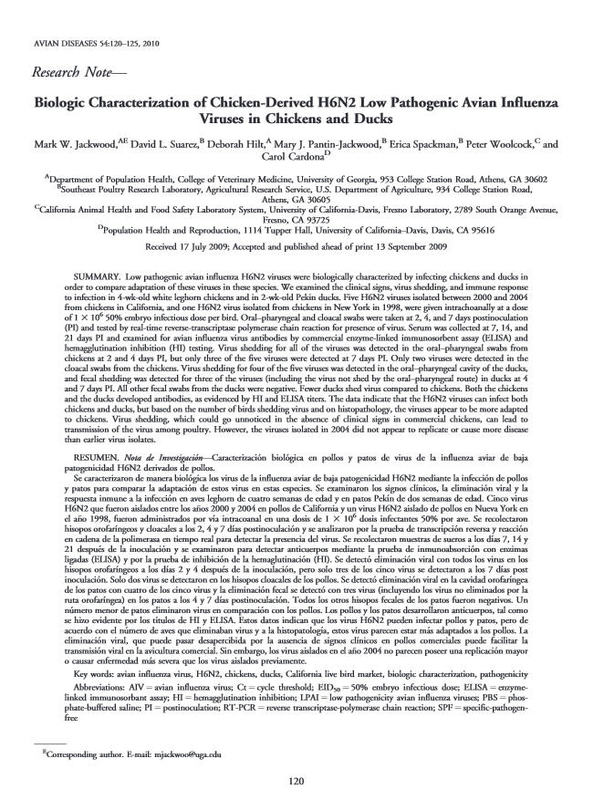Biologic Characterization of Chicken-Derived H6N2 Low Pathogenic Avian Influenza Viruses in Chickens and Ducks
Title
Biologic Characterization of Chicken-Derived H6N2 Low Pathogenic Avian Influenza Viruses in Chickens and Ducks
Creator
Date
Subject
Excerpt
Low pathogenic avian influenza H6N2 viruses were biologically characterized by infecting chickens and ducks in order to compare adaptation of these viruses in these species. We examined the clinical signs, virus shedding, and immune response to infection in 4-wk-old white leghorn chickens and in 2-wk-old Pekin ducks. Five H6N2 viruses isolated between 2000 and 2004 from chickens in California, and one H6N2 virus isolated from chickens in New York in 1998, were given intrachoanally at a dose of 1 × 10(6) 50% embryo infectious dose per bird. Oral–pharyngeal and cloacal swabs were taken at 2, 4, and 7 days postinoculation (PI) and tested by real-time reverse-transcriptase polymerase chain reaction for presence of virus. Serum was collected at 7, 14, and 21 days PI and examined for avian influenza virus antibodies by commercial enzyme-linked immunosorbent assay (ELISA) and hemagglutination inhibition (HI) testing. Virus shedding for all of the viruses was detected in the oral–pharyngeal swabs from chickens at 2 and 4 days PI, but only three of the five viruses were detected at 7 days PI. Only two viruses were detected in the cloacal swabs from the chickens. Virus shedding for four of the five viruses was detected in the oral–pharyngeal cavity of the ducks, and fecal shedding was detected for three of the viruses (including the virus not shed by the oral–pharyngeal route) in ducks at 4 and 7 days PI. All other fecal swabs from the ducks were negative. Fewer ducks shed virus compared to chickens. Both the chickens and the ducks developed antibodies, as evidenced by HI and ELISA titers. The data indicate that the H6N2 viruses can infect both chickens and ducks, but based on the number of birds shedding virus and on histopathology, the viruses appear to be more adapted to chickens. Virus shedding, which could go unnoticed in the absence of clinical signs in commercial chickens, can lead to transmission of the virus among poultry. However, the viruses isolated in 2004 did not appear to replicate or cause more disease than earlier virus isolates.
Relation
Avian Diseases
Volume 54, Issue 1
pp. 120-125
 An official website of the United States government.
An official website of the United States government.


